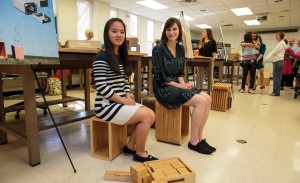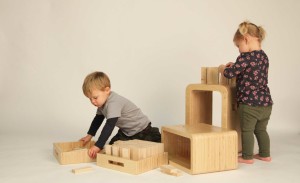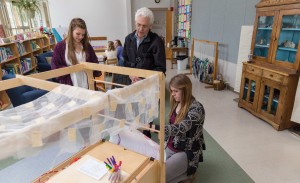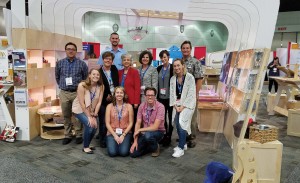When sitting in Interior Design Studio 352, Grey Waletich ’16 was not sure what to expect from a project that called for her and her peers to create furniture for an early childhood education classroom.

Grey Waletich, right, sits on a Flexnest with Vanny Cahyadi, her studio project partner, after working on that project at State.
The project, now in its fourth year at South Dakota State University, created a career for Waletich, a native of Eden. She is in her second year working full time as a product designer at Kodo Kids, which designs products for children that encourages investigation-based learning and open-ended play and is based in Bloomfield, Colorado.
Waletich got on Kodo’s radar after she and classmate Vanny Cahyadi developed the Flexnest, which can be described as a group of wood objects that stack inside each other and can be used in various ways. Flexnest was awarded “Best in Category: Design as an Idea†by the Interior Design Educators Council in 2017.
Waletich found her calling when designing Flexnest and observing how it was used by students in the Fishback Center for Early Childhood Education. The class project started following a discussion between Angela McKillip, an assistant professor in interior design, and Kay Cutler, the Fishback Center’s director. They later had a conversation with Chris Hume, the executive director and founder of Kodo Kids, and the idea became a reality in 2015.
The initial eight-week project created the DiscoveryHub and Flexnest prototypes, which were on display at the National Association for the Education of Young Children’s Expo in November 2015 and then at NYCxDESIGN week at ICFF® in 2016. The following year, the lead project, the Maker-Table, was debuted to the National Association for the Education of Young Children’s Expo. The short-run production and national product testing and research phases for the Teasel, the lead project in 2017, is just wrapping up.

The Flexnest was listed by Fast Company as one of the best nine ideas for tiny spaces from the 2016 New York Design Week.
“The biggest thing I learned from the studio course was removing my preconceptions of who we were designing for in order to create a valuable product,†Waletich said. “We learned about our client, the child, through interaction and observation. Before we fully understood our client, we put safety as one of the core aspects of our design, but in reality, risk taking, creativity and exploratory experience are most important for the early childhood education classroom.
“I found my interest in the details—understanding the quality of a material, the way that the materials can be joined, the anthropometrics of a child’s hand, the process of actually building the product and the most rewarding part, observing the product being used,†she continued.
Flexnest was also on display at the National Association for the Education of Young Children’s Expo and at NYCxDESIGN week at ICFF®. South Dakota State was one of 13 institutions selected to exhibit at the 2016 ICFF event.
That initial success has allowed the partnership between interior design students, the Fishback Center for Early Childhood Education and Kodo Kids to grow into its fourth year. Mechanical engineering, advertising and entrepreneurial studies students also participated this past spring semester.
“We’re impacting a core of students at the moment but the reach of this could be so much greater. While we’re running with this expanded collaboration this year, we’re thinking about what else and what other experiences like this could be formed at SDSU that would have an even bigger impact on our students,†McKillip said.

Students receive feedback from students and faculty during an event at the Fishback Center for Early Childhood Education.
The latest projects are under the watchful eye of Waletich, who provides feedback. “I remember being in their position and hope I’m able to provide input or feedback that is beneficial,†Waletich said. “I have gathered more knowledge around early childhood education from working in the field the last two years and hope I was able to add another layer of insight to their research and development of their project. I also hope I reduced some of their anxieties of presenting to an industry partner because I have been in their shoes before.â€Â
“I’m very excited and slightly envious of the new cross department collaboration. Good things always come from collaborating with individuals with unique skillsets,†she continued. “I’m glad to see how the course is progressing and impacting the design students at State. The students and professors should be very proud of their work.â€
Waletich is not the only recent graduate who helped out this year. When visiting campus in early 2018 after an overseas internship ended, Natalie Parks ’17 asked McKillip how the class was going and if she could re-engage. McKillip soon brought Parks on as an assistant.
“Having had the privilege of seeing and interacting with products from Kodo Kids gave me additional insight into the types of products that it is drawn toward and want to take further,†Parks said. “Simply being through the project, one learns so much about the client and design process. Those experiences allowed me to guide students toward personal inquiry and discovery while creating a viable, feasible and desirable product.
“I would love to continue helping in the future,†she continued. “I think having gone through this project as a student, a student researcher and now as a classroom assistant, I am able to bring a perspective that both helps me relate to a student’s experience as well as help them look beyond what they may see as frustrations. It’s also just a fun project to be a part of!â€

Grey Waletich and Kodo Kids at an early childhood education conference. Waletich is in the back row in a gray shirt. Chris Hume, founder of Kodo Kids, is in the front with glasses.
According to Waletich, the project allows one to create something that would impact someone in a beneficial way and something she tries to do with each project at Kodo.
“At the time, I had thought of going to school for architecture, but I didn’t want to pass up the opportunity in front of me,†she said. “For me, the switch happened when we were observing our product being used in a classroom and how it was supporting the learning environment. That’s when I realized how much I enjoy designing for early childhood education and how it could be the career for me.â€
– Matt Schmidt






